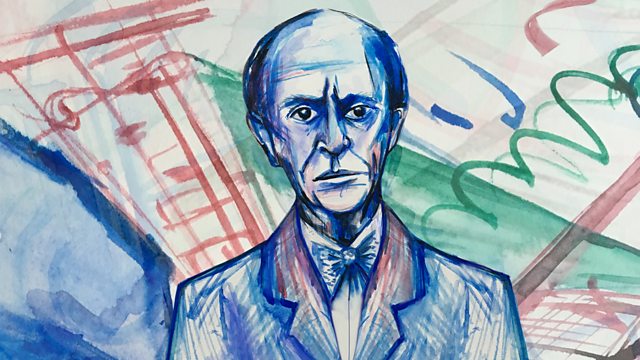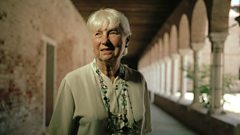Breaking Free - the minds that changed music
Tom Service talks to Schoenberg's daughter, Nuria Schoenberg Nono, and discusses the legacy of the Second Viennese School. Tom McKinney visits the Schonberg-Haus near Vienna.
Tom Service talks to Schoenberg's daughter, Nuria Schoenberg Nono, and discusses the legacy of the whole Second Viennese School with Professor Julian Johnson, Gillian Moore - Director of Music, Southbank Centre - and composer Gabriel Prokofiev. Composer-conductors Reinbert de Leeuw and HK Gruber talk about the challenges and rewards of performing the orchestral works of Schoenberg, Berg and Webern. Plus Tom McKinney is joined by curator Therese Muxeneder as he visits the Schönberg-Haus in Mödling, just outside Vienna, which is known as the "birthplace of twelve-tone music".
Last on
More episodes
Clips
Breaking Free: how successful were they?

1923 is generally considered the year in which Arnold Schoenberg ‘revealed’ his twelve-tone method of composition to a group of students. Schoenberg’s declaration that he had discovered his method for composing with 12 tones, ensuring ‘the supremacy of German music for the next hundred years’, is often quoted as a landmark moment in the history of music. This method would be adopted by many of his students, but most famously Anton Webern and Alban Berg, who would join him in history books to become known as the Second Viennese School. But more than 90 years later, what impact did this movement have on music and did they in fact ‘break free’ from their musical pasts?
Concluding a week dedicated to the music of the Second Viennese School, Tom asks whether the methods and emancipated sounds of Arnold Schoenberg, Anton Webern and Alban Berg were really ‘breaking free’ from the past, and where this crucial movement has taken musical culture since. He is joined by Gillian Moore, Director of Music at the Southbank Centre in London; composer Gabriel Prokofiev and Julian Johnson, Regius Professor of Music at Royal Holloway, University of London. Each of them discovered this music as teenagers and talk to Tom about their different encounters with this revolutionary new sound world.
To uncover more of a sense of the man and his environment, Tom McKinney visits the Schoenberg House in Mödling, a short distance from Vienna, which is now called the birth place of the twelve-note method. Here, Tom explores Schoenberg’s former home with the chief archivist of the Arnold Schoenberg Centre in Vienna, Therese Muxeneder. They look at objects from Schoenberg’s musical instruments (including his harmonium) to music stands he had specially designed for the likes of the Kolisch Quartet.
A legacy to be proud of

‘A system doesn’t automatically create music, so you have to be a composer to interpret the method’ says Therese Muxeneder. So what is the legacy of this method, and how have composers down the ages chosen to interpret it? The panel compares the feeling at the time that a new system of composition was needed with the possibly more disparate influences and approaches today. And to the question did they ‘break free’, they consider the fact that what Schoenberg proposed wasn’t a diktat and that tradition itself wasn’t abandoned.
Humanising Schoenberg

Discussing the legacy of her father’s music, Tom talks to Schoenberg’s daughter, Nuria Schoenberg-Nono. ‘The emotions are there’, says Nuria, ‘you can understand these without knowing precisely what they’re referring to’. She argues that it takes performers who understand her father’s music to communicate it, and describes her own journey in understanding and valuing it. She describes hearing someone leaving after a performance of the Op. 31 Variations at La Scala in Milan singing the theme: ‘he was right, people will whistle his music on the street; I wish I could tell him this’.
How we respond to this music is considered by the panel. They offer an insight into the way the music of the Second Viennese School is programmed, and consider the importance of ‘humanising’ it.
��
Responding to the music

Conductors Reinbert de Leeuw (founder of the Schoenberg Ensemble in 1974) and HK Gruber (composer of the so-called ‘Third Viennese School’ of music) give their strong views on the music of Schoenberg, Berg and Webern, through years of engaging with it as composers and conductors. De Leeuw considers the 12-note system ‘tragic’ and talks about the perils of a system that, he believes, ultimately destroyed Schoenberg’s fantasy. And HK Gruber, whilst loving the music of Berg, believes that Schoenberg’s big invention was that the audience had to ‘suffer’.
For Gabriel Prokofiev the legacy doesn’t lie in using the twelve-tone method as a composer, but in challenging composers to come up with their own systems and approaches. Julian Johnson believes that this music has had a ‘profound impact on the way of thinking and the conception of musical sound and space’. And Gillian Moore believes that whilst the method was perhaps a short lived phenomenon, it has reverberated well beyond its time.
More information
����
��
Credits
| Role | Contributor |
|---|---|
| Presenter | Tom Service |
| Interviewed Guest | Nuria Schoenberg Nono |
| Interviewed Guest | Julian Johnson |
| Interviewed Guest | Gillian Moore |
| Interviewed Guest | Gabriel Prokofiev |
| Interviewed Guest | Reinbert de Leeuw |
| Interviewed Guest | HK Gruber |
| Interviewer | Tom McKinney |
| Interviewed Guest | Therese Muxeneder |
Broadcasts
- Sat 7 Jan 2017 12:1591�ȱ� Radio 3
- Mon 9 Jan 2017 22:0091�ȱ� Radio 3
Knock on wood – six stunning wooden concert halls around the world
Steel and concrete can't beat good old wood to produce the best sounds for music.
The evolution of video game music
Tom Service traces the rise of an exciting new genre, from bleeps to responsive scores.
Why music can literally make us lose track of time
Try our psychoacoustic experiment to see how tempo can affect your timekeeping abilities.
Podcast
-
![]()
Music Matters
The stories that matter, the people that matter, the music that matters



